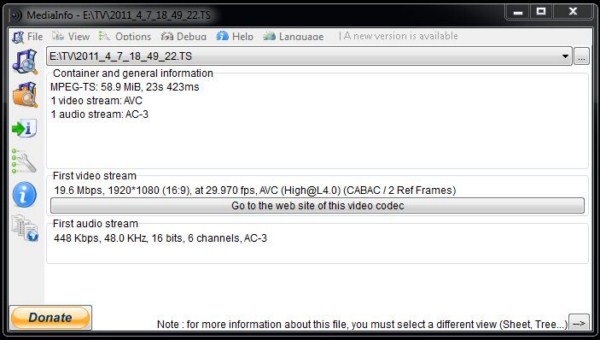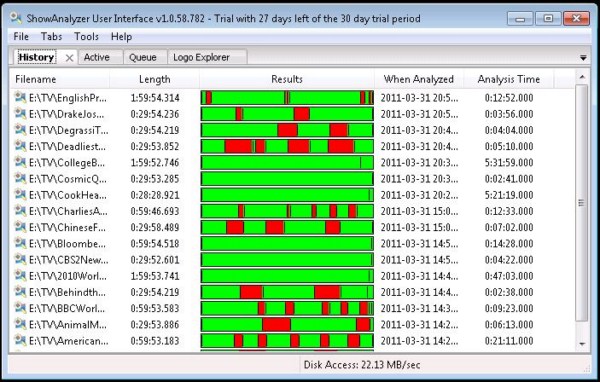Hauppauge Colossus: HD PVR with HDMI Support
by Andrew Van Til on April 14, 2011 5:40 PM EST- Posted in
- HTPC
- Home Theater
- Hauppauge
Testing and Evaluation
With an original HD PVR and Ceton InfiniTV 4 Digital Cable Tuner (DCT) on hand, it provided us with the opportunity to record the same content using MediaInfo and perform visual inspections to document differences in quality. For the results above, the Colossus and HD PVR were configured in-line using the YPbPr/TOSLINK pass-through from the STB. They were set to use the highest recording profile in SageTV, with SageDCT used to capture the raw TS stream from the InfiniTV 4 as a reference point. The settings used by the various devices are summarized in the following table.
| Device Recording Profile Summary | |||
| Video Resolution | Colossus | HD PVR | SageDCT (RAW) |
| 480i | 3985 Kbps 720x480@29.97 AVC (Main@L3.2) (CABAC/2 Ref Frames) | 4695 Kbps 720x480@29.97 AVC (Main@L3.1) (CABAC/4 Ref Frames) | 2948 Kbps 528x480@29.97 MPEG2 (Main@Main) |
| 720p | 7924 Kbps 1280x720p@59.94 AVC (High@L4.0) (CABAC/2 Ref Frames) | 11.8 Mbps 1280x720@59.94 AVC (Main@4.0) (CABAC/4 Ref Frames) | 10.5 Mbps 1280x720@59.94 MPEG2 (Main@High) |
| 1080i | 12.7Mbps 1920x1080i@29.97 AVC (High@L4.0) (CABAC/2 Ref Frames) | 11.7Mbps 1920x1080i@29.97 AVC (High@L4.0) (CABAC/4 Ref Frames) | 16.5 Mbps 1920x1080@29.97 MPEG2 (Main@High) |
There are differences in the bitrate and AVC profiles used by the two Hauppauge devices; the Colossus uses a higher rate for 1080i and the HD PVR uses higher bitrates for 720p and 480i. The InfiniTV 4 was a third set of values. With three points of reference and digital source content, there is little noticeable difference between the captured files in real terms. (If you’re interested in seeing clips of the videos, let us know and we’ll see about including download links.
Alongside the comparative testing, the Colossus was also evaluated for the overall quality and “watchability” of recordings captured at native resolution from the STB. We recorded sixty files with a 33% distribution per resolution at random intervals and channels, and then sampled at five to ten points in each file for issues related to audio and video. We looked for A/V synchronization problems, stutter, and dropouts, and the final result is an 8.33% fail rate. Most of the “fail” issues only occurred in specific locations in the files, and while annoying they were not severe enough to abandon playback. However, there were also entire recordings with no audio or significant enough issues with audio drops or video playback that continued viewing was very unpleasant or impossible.

Before moving on it is interesting to note that the maximum bitrate available in ShowBiz and via the encoder’s property page (shown below) is quite a bit higher (~20Mbps) than what is used by SageTV when selecting the best rate (~14 Mbps). It is unlikely that the value of encoding at this high a level would result in a great enough pay off to justify the increased file size given the bitrate of most TV content, but it is good to know that it is possible if the content warrants it.
Additional Testing
I love it when my interests in the HTPC space overlap, so having observed the difference in bitrate capabilities and issues with file capture it provided an easy excuse to start writing code against the Colossus and figure out how to drive the device. For anyone who has done any playing with DirectShow, the following screenshot of the capture graph in GraphStudio should be very familiar. It demonstrates the four components necessary to enable file capture from the device with the property pages for the “Capture” and “Encoder” filters (which are what ShowBiz exposes through its GUI) displayed. The file sink—the component at the end that writes the TS packets to disk as they are output from the encoder (in this case a slightly customized version of the “Dump” sample included in the Windows SDK)—is the only filter not provided by the drivers.

Using that as a starting point I wrote a simple application to prototype input selection (it supports component + S/PDIF or HDMI) and filter configuration. Using standard DirectShow interfaces, I was able to reproduce both the capture issues and the inconsistent bitrate values observed with ShowBiz and SageTV, where after setting the device to the maximum bitrate (~20Mbps) through the encoder interface it actually uses ~14Mbps. I have asked Hauppauge to provide documentation for programming against the device in case there is a different, non-obvious, mechanism for configuring the card, but they did not provide it in time for this review. For anyone interested in looking at the source code for the application it is available here.

Anyone who made the jump to the original HD PVR when it was released will remember that the commercial scanning story was a bit troubled. Fortunately, the work that was done to support the AVC TS files created with it carries over to those generated using the Colossus. Applications like ShowAnalyzer are able to scan the files and detect commercials in them.










60 Comments
View All Comments
Casper42 - Monday, April 25, 2011 - link
PS: This is even worse with U-verse here in the USA.Microsoft developed product (aka MS Media Room) that streams over Multicast IP networks to a Windows CE 5.x based STB/DVR, and is supported by MS/AT&T with a Xbox 360 client, but yet there is no Win7MC Client that can do the same on a PC thats 10x faster?
Absolute lunacy. I'm sure it exists but companies like Cable Labs are preventing it from being released. Just think, 100% digital copies of the shows you want delivered straight over a simple network connection. Its so easy it must be illegal!
Shadowmaster625 - Monday, April 18, 2011 - link
You can say that again. Every time I buy a TV tuner card, even the ones that get the best reviews on newegg and other sites, I end up being sorely disappointed and am left wondering what the heck all those people were smoking when they recommended the card. These things just do not work and it will take me a hell of a lot of convincing to fool me into trying another one. Especially when a seedbox only costs $8 a month. lol. I just let some other sucker record my stuff for me. (What is the difference anyway?)strolfey - Monday, April 18, 2011 - link
It was briefly mentioned that none of the PACE codes worked with the RNG 110, but then the ir blaster wasn't ever mentioned again. Did you get a different code that worked with it? I bought the HD-PVR last december and haven't actually used it since because of that issue, and hauppage never got back to me on that or other issues I've had. Google results on the issue at the time were mixed, with some saying that it worked with the old comcast code (fairly certain they're liars since most of the results were talking about how comcast changed remotes and lots of people had problems) and many saying they returned the STB back for an older model.babgvant - Wednesday, April 20, 2011 - link
I was not able to find a code that worked with the Pace STB. It should be possible to train the blaster, but the software doesn't work very well so it's better to go another route (FW, ethernet, serial, USBIRT, etc).don_k - Thursday, April 21, 2011 - link
What's the word on Linux support for these cards, anyone know? Hauppauge site claims no support as of yet.http://www.hauppauge.com/site/support/support_colo...
chordo - Saturday, April 23, 2011 - link
Hauppauge has released a new driver plus beta software to integrate Colossus with Media Center. Pretty good start, although it only currently supports stereo audio. According to the website, optical will be supported in the next release. I have been using DVBLink up to now, and I have not had any problems using optical (no audio sync issues).Octavean - Saturday, April 23, 2011 - link
I have two Hauppauge HD PVR units. I bought my first unit in 2008 and I have never really had any significant problems with them. I started off using the bundled OEM Arcsoft TotalMedia Extreme software and then graduated to the DVBLink solution. I also beta tested the Hauppauge Media Center solution but found the DVBLink solution to be more stable.I bought one Colossus for ~$139 or so via the special pricing for the pre-order and I am very pleased with it. It is extremely stable when used with DVBLink and has never shown any sign of an issue small or otherwise.
Right now I use a Hauppauge HD PVR USB in the bedroom and a Hauppauge Colossus in the living room. An HP MediaSmart EX490 Windows Home Server provides whole house DRM free entertainment to every system by acting as a repository ~12TB.
I wouldn’t trade two Hauppauge HD PVR / Colossus 1080i / 720p DRM free streams for 4 Ceton InfiniTV quad streams with DRM.
heric1 - Friday, May 27, 2011 - link
About this comment : "the final result is an 8.33% fail rate". I am curious to know if the last driver version (29111) was tested...? The release date was 4/22/2011.http://www.hauppauge.com/site/support/support_colo...
The web site pretends this release fixes:
-"Colossus audio lost when another recording starts in Sage TV"
-"My player loses audio if the audio format changes in the middle of a recording"
I think it's also the first version with MCE integration:
"This version now has support for Windows Media Center."
Tosa - Wednesday, June 15, 2011 - link
I was in the market for a HD capture card and bought the Blackmagic Intensity Pro card just before the Hauppauge Colossus came out. (I don't want an external box like HD PVR). Price is about the same. I kicked myself for not waiting a bit for the Colossus and see how it perform.Anyhow I now have 3 month using the Intensity Pro, and compare it with this review. My use is to record from sat channels, and occasionally record games (HDMI connection, 1080i/59.94). After the usual teething problems with PC and the Intensity product, here's my experience:
- Record 1080i/59.94 for hours with no problems - no frame drops, no audio drops, no blue screen. Thus app & drivers are stable. (Windows 7-32)
- Can record to 480p
- HD quality is absolutely superb. Indistinguishable from the original, no matter what kind of scene, as critically viewed from a high end HDTV.
- The Intensity Pro record HD at a frame rate of 15 mbps, sustained.
- The only issue is it records using Motion-JPEG compression and thus yields huge AVI files at a rate of 35GB/hr. This is 'fixed' by importing AVI file into my video editor (Corel VideoStudio Pro X3) and convert it to H.264 compression and AVCHD file. The result reduce a 36GB AVI file to 6GB. The AVCHD file can be played by most players.
So the Intensity Pro is completely satisfactory. In this review, I notice that the Colossus:
- Record HD to 1080i at 30/fs only
- Bit rate is slightly less than 15mbps
- Record direct to AVCHD file, smaller size, and immediately usable
- Drivers not stable
But I can tell you this: both cards spits out a lot of heat. That's the nature of the beast. In my case, the Intensity card plus the Radeon HD 5670 graphics card generate so much heat I have to do a lot of cooling work to fix it.
arshaavin - Sunday, July 3, 2011 - link
Hi all, I wanna know where i can buy hauppauge hd pvr in india at reasonable price.I really need this.arshaavin@yahoo.com